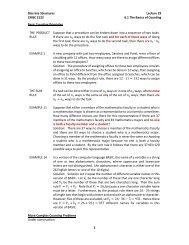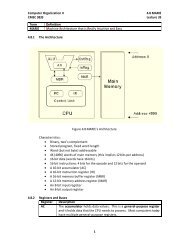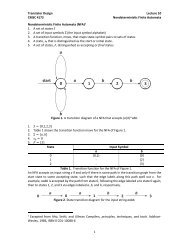Rosen, 5.4 Binomial Coefficients
Rosen, 5.4 Binomial Coefficients
Rosen, 5.4 Binomial Coefficients
Create successful ePaper yourself
Turn your PDF publications into a flip-book with our unique Google optimized e-Paper software.
Discrete Structures Lecture 27<br />
CMSC 2123<br />
8.2 Solving Linear Recurrence Relations<br />
DEFINITION 1<br />
EXAMPLE 1<br />
EXAMPLE 2<br />
A linear homogeneous recurrence relation of degree k with constant<br />
coefficients is a recurrence relation of the form<br />
aa nn = cc 1 aa nn−1 + cc 2 aa nn−2 + ⋯ + cc kk aa nn−kk<br />
where cc 1 , cc 2 , ⋯ , cc kk are real numbers and cc kk ≠ 0.<br />
The recurrence relation PP nn = (1.11)PP nn−1 is a linear homogenous recurrence<br />
relation of degree one. The recurrence relations ff nn = ff nn−1 + ff nn−2 is a linear<br />
homogeneous recurrence relation of degree two. The recurrence relation<br />
aa nn = aa nn−5 is a linear homogeneous recurrence relation of degree five.<br />
2<br />
The recurrence relation aa nn = aa nn−1 + aa nn−2 is not linear. The recurrence<br />
relation HH nn = 2HH nn−1 + 1 is not homogeneous. The recurrence relation BB nn =<br />
nnBB nn−1 does not have constant coefficients.<br />
Solving Linear Homogeneous Recurrence Relations with Constant <strong>Coefficients</strong><br />
The basic approach for solving linear homogeneous recurrence relations is to look for solutions of<br />
the form aa nn = rr nn , where rr is a constant. Note that aa nn = rr nn is a solution of the recurrence<br />
relation aa nn = cc 1 aa nn−1 + cc 2 aa nn−2 + ⋯ + cc kk aa nn−kk if and only if<br />
rr nn = cc 1 rr nn−1 + cc 2 rr nn−2 + ⋯ + cc kk rr nn−kk<br />
When both sides are divided by rr nn−kk and the right-hand side is subtracted from the left, we obtain<br />
the equations<br />
rr kk − cc 1 rr kk−1 − cc 2 rr kk−2 − ⋯ − cc kk−1 rr − cc kk = 0<br />
Consequently, the sequence {aa nn } with aa nn = rr nn is a solution if and only if rr is a solution of this last<br />
equation. We call this the characteristic equation of the recurrence relation. The solutions of<br />
this equation are called the characteristic roots of the recurrence relation.<br />
THEOREM 1 Let cc 1 and cc 2 be real numbers. Suppose rr 2 − cc 1 rr − cc 2 = 0 has two distinct<br />
roots rr 1 and rr 2 . Then the sequence {aa nn }is a solution of the recurrence relation<br />
aa nn = cc 1 aa nn−1 + cc 2 aa nn−2 if and only if aa nn = αα 1 rr nn nn<br />
1 + αα 2 rr 2 for nn = 1, 2, …,<br />
where αα 1 and αα 2 are constants.<br />
EXAMPLE 3<br />
What is the solution of the recurrence relation<br />
aa nn = aa nn−1 + 2aa nn−2<br />
with aa 0 = 2 and aa 1 = 7?<br />
Solution: Theorem 1 can be used to solve this problem. The characteristic<br />
equation of the recurrence relation is rr 2 − rr − 2 = 0. Its roots are rr = 2<br />
and rr = −1. Hence the sequence {aa nn } is a solution to the recurrence relation<br />
if and only if<br />
aa nn = αα 1 2 nn + αα 2 (−1) nn<br />
for some constants αα 1 and αα 2 . From the initial conditions, it follows that<br />
aa 0 = 2 = αα 1 + αα 2<br />
aa 1 = 7 = αα 1 ∙ 2 + αα 2 ∙ (−1)<br />
Solving these two equations show that αα 1 = 3 and αα 2 = −1. Hence, the<br />
solution to the recurrence relation and initial conditions is the sequence {aa nn }<br />
with<br />
aa nn = 3 ∙ 2 nn − (−1) nn<br />
1
Discrete Structures Lecture 27<br />
CMSC 2123<br />
8.2 Solving Linear Recurrence Relations<br />
EXAMPLE 3.1<br />
What is the solution of the recurrence relation<br />
aa kk = 1 2 aa kk−1<br />
with aa 0 = NN?<br />
Solution: Theorem 1 can be used to solve this problem. The characteristic<br />
equation of the recurrence relation is rr − 1 = 0. Its root is = 1 . Hence the<br />
2 2<br />
sequence {aa nn } is a solution to the recurrence relation if and only if<br />
aa kk = αα 1 1 kk<br />
2 <br />
for a constants αα 1 . From the initial conditions, it follows that<br />
aa 0 = NN = αα 1<br />
Solving these two equations show that αα 1 = NN. Hence, the solution to the<br />
recurrence relation and initial conditions is the sequence {aa kk } with<br />
aa kk = NN kk<br />
2 <br />
EXAMPLE 4<br />
Find an explicit formula for the Fibonacci numbers.<br />
Solution: Type equation here.<br />
2





